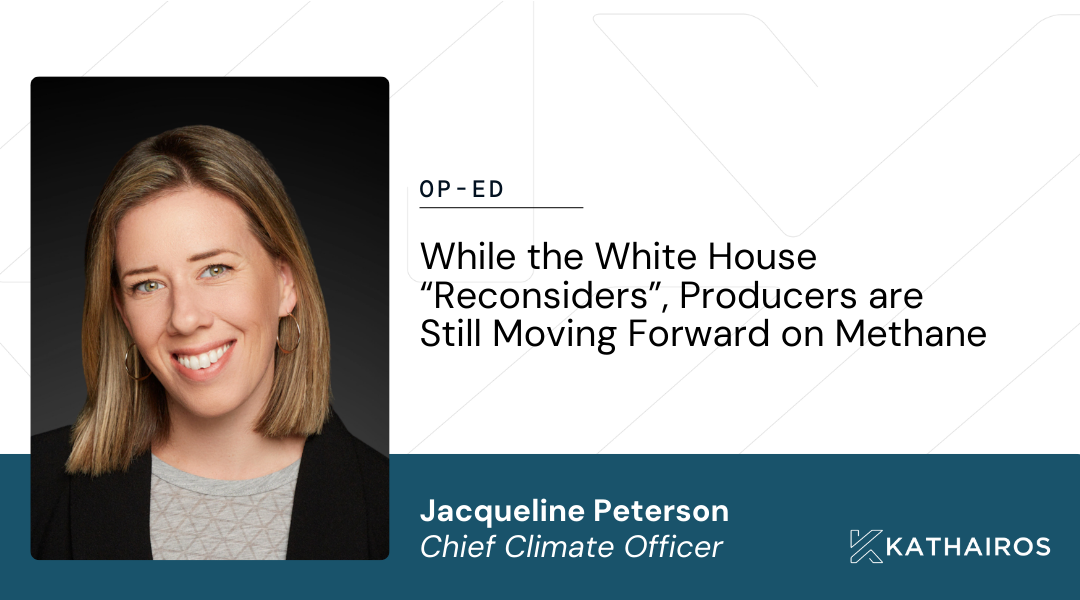
Kathairos has emerged as the leading North American solution for methane elimination from pneumatics, with more than 1,000 systems in operation across North America and over 40 major oil and gas producer partners.
In this post
Below is an op-ed from Jacqueline Peterson, PhD, Chief Climate Officer at Kathairos, exploring why oil and gas producers continue advancing methane mitigation—driven by technology, corporate strategy, and global market demands, regardless of shifting regulations.
At CERAWeek 2025, the narrative couldn’t have been more different than the year prior. Gone were the conversations about hydrogen, environmental justice and the “energy transition.” In was a focus on “energy expansion” and ensuring oil and gas dominance in a “complex world.” Amidst the frenzy of the week, EPA also announced its “Biggest Deregulatory Action in U.S. History” and a commitment to “reconsider” some of the methane policies approved under the Biden administration. Yet despite “climate” references being dropped from discourse at CERAWeek, talk about methane measurement and reduction was on the rise. What gives?
I argue that that producers have not moved away from methane action but have instead moved beyond it. It is now a given amongst most industry actors that methane should be kept in the pipe for sale, not vented into the atmosphere. Today’s conversations are not whether to mitigate methane, but the more practical considerations of how to do it most effectively and affordably.
There are 3 main factors driving methane action today: 1) growing awareness and understanding of methane emission sources, 2) internal corporate mandates and 3) access to international markets. These inter-related factors have led to the steady increase in methane mitigation over the past ten years. Additionally, while regulatory environment (4) may not be at the top of the list, it is still factoring into investment decisions, particularly with respect to compliance and risk management.
Growing awareness of the methane problem
Methane is colorless and odorless; you can’t see it and you can’t smell it. As a result, there has historically been minimal attention paid to the natural gas released during oil and gas production and transmission activities. In the past two decades, many new technologies have emerged that allow methane to be “seen.” The accuracy, coverage and sensitivity of these technologies (satellites, drones, continuous sensors, optical gas imaging cameras) have improved every year, allowing operators to better understand the source of leaks and vented gas and measure the amount of gas lost. Over the past twenty years, society has also become more aware of the particular potency of methane as a greenhouse gas.
In order to solve a problem, you have to first know it exists. Unlike in the 20th century, there is now general understanding within industry that venting methane is undesirable and should be avoided when possible.
Internal corporate mandates
People that work in oil and gas know the industry is committed to environmental stewardship, employing best practices and maximizing efficiencies. It is also common for shareholders to voice concerns and direct companies to incorporate emissions reductions into long-term strategic plans. For these reasons, many companies have set internal methane reduction commitments to minimize both carbon intensity and product loss. These plans and commitments often span multiple years and are executed regardless of the regulatory context, which are unpredictable and can swing significantly between administrations. As one industry rep told me at CERAWeek, “If we ping-ponged between every administration, we wouldn’t get anything done.” Most companies operate at longer time horizons and determine the value of investments based on long-term trends and market forces.
Access to international markets
Emissions intensity is becoming increasingly integrated into international oil and gas import/export requirements. As such, it has been critical for oil and gas producers to better measure (and ultimately, reduce) methane emissions in order to compete in international markets.
The European Union's Methane Regulation (EU/2024/1787) came into force on August 4, 2024, and applies to a variety of energy products, including liquefied natural gas (LNG). The regulation places significant emphasis on emissions reporting and measurement (equivalent to EU standards) as well as a maximum methane intensity value for natural gas imports, which will take effect in 2030. Additionally, the “Coalition for LNG Emission Abatement toward Net-zero (CLEAN)” was recently established in Japan and South Korea to enhance transparency and reduce methane emissions across the LNG value chain.
Given international pressures, oil and gas exporters are looking to source product that meets these new methane import requirements. This push is filtering down to oil and gas producers who are beginning to develop and implement methane reporting and mitigation plans in order to comply and access new markets.
Regulatory risk
Finally, while not the primary driver, domestic regulatory considerations still play a role. Regulatory reviews and legal challenges will likely take years to complete and resolve. While there may be some tweaks to timelines or eligible facilities, the OOOOc regulations passed in 2023 are unlikely to be rescinded completely. Additionally, OOOOb has been in place for close to a year, and it is hard to envision a scenario wherein new facilities purposely incorporate methane venting into the design. Companies waiting to see how the dust settles may find themselves in a supply-chain bind or face compliance risks if the existing regulations are upheld and/or administration changes. For the time being, OOOOb/c continues to stand. Moreover, many states, such as Colorado, continue to move forward with their own state regulations.
Summary
Despite the uncertain times in which we find ourselves, oil and gas producers continue to advance methane mitigation due to economic and market-driven factors. Industry discussions have shifted from whether to reduce methane emissions to how best to do so, driven by technological advancements, corporate mandates, and international market requirements. To be sure, methane action requires leadership. Luckily, there is a strong business case to back it up.


